Scientists at the University of York in UK discovered evidence of a line that they labeled "chemical equator," and which separates the northern hemisphere of the planet from its southern counterpart, in terms of pollution.
The discovered line is 30 miles (50 km) wide and resides in the cloudless sky of the Western Pacific area. Basically, it is what keeps the pollutants from the northern hemisphere from reaching further south and contaminating the regions of the southern one. The study developed by the Chemistry Department of Britain's University of York indicated that, while the phenomenon of pollution is long known, monitored and studied, the big difference in pollution levels between north and south is totally unexpected. Thus, the carbon monoxide level in the northern part is four times greater than the one in the southern region. This huge difference is believed to be caused by the massive amounts of wildfires that occurred on the northern side.
Prior to this finding, experts relied on their calculations obtained via the Intertropical Convergence Zone (ITCZ), an area where the trade winds from the two hemispheres violently meet. The aftermath of their collision leads to the creation of a low pressure system that causes heavy, excessive rain and vertical uplifts, forming a barrier impassable by pollutants. Jacqueline Hamilton, an expert from the University of York, states that "The shallow waters of the Western Pacific, known as the Tropical Warm Pool, have some of highest sea surface temperatures in the world, which result in the region's weather being dominated by storm systems. The position of the chemical equator was to the south of this stormy region. Powerful storms may act as pumps, lifting highly polluted air from the surface to high in the atmosphere where pollutants will remain longer and may have a global influence."
The recent finding of the "chemical equator" will aid researchers in their attempt to create models of the atmospheric pollution level activity, as well as to better predict climate changes. It will also help them better understand the impact of pollutants on global climate, through their new Aerosol and Chemical Transportation in Tropical Convention (ACTIVE) project which studies the chemical composition of the northern tropical troposphere.

 14 DAY TRIAL //
14 DAY TRIAL //